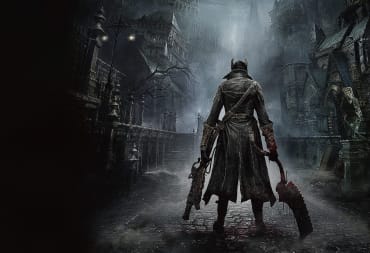Bloodborne is my favorite of From Software's iconic Soulsborne series. Not only was it a brutal and harsh action RPG, but the entire setting dripped with gothic dread, a ghoulish and diseased atmosphere, and unsettling cosmic horror. It did a great job making you feel like you were trapped in a nightmare with lucid but somehow inconsistent dream logic, even while you were slicing through beast monsters like a human blender. That exact same blend of horror, suspense, and high-intensity action is replicated in the aptly named Bloodborne: The Board Game, designed by Michael Shinall and Eric M. Lang and published by CMON Global Limited.

Bloodborne: The Board Game is a campaign-driven cooperative deckbuilding tile-based game. One to four players choose a Hunter to play as, each one with their own unique starting weapon and firearm, and collectively work together to explore the city of Yharnam and complete mission objectives. As you explore the town, tiles are added to the map, expanding the play space. Each player has a deck of cards that they use for combat and actions. Completing missions reward new weapons, tools, magic runes, and consumable items to help in the hunt. All of this is done on a timer track. If you and your team do not complete these objectives before a set number of turns, Yharnam is overwhelmed by monsters and the players lose. Complete these objectives in time and the board is reset for the next part of the campaign.
Right off the bat, the board game adapts the source material admirably. You gain blood echoes when killing an enemy, but lose all of them if you die. Once the game hits a certain turn limit, enemies respawn and bosses heal all damage done to them. Fog gates lock off parts of the map when you face a major enemy, but other players can warp to the fight if they're in an area with a lantern. Even the game's signature trick weapons are represented. Your weapon on the hunter dashboard has three distinct slots that correspond with a certain attack. In order to use one of these attacks, you fill that slot with a card from your hand. Once all of those slots are filled, you have to switch your weapon, which involves you flipping the card over, revealing the transformed weapon along with three new slots. It's a clever way to show the versatility of the weapon while balancing the game's action economy.
Much like the videogame source material, there are builds you can construct with the various cards that make up your deck. Each card is related to one of four different stats and the more powerful cards you can buy in the shop, and their respective stats have clear and obvious benefits. Strength cards do extra damage, vitality cards let you heal while attacking, skill cards make you harder to hit, the list goes on. It encourages a dedicated build that works best with your weapon and relative playstyle since combat is based entirely on activating attacks with cards rather than the randomness of rolling dice. If you build the engine for the right function, it will not let you down.

It's a system you'll have plenty of time to be familiar with. A session of Bloodborne: The Board Game claims it can go from an hour to an hour and a half, and if you're aiming to complete a campaign chapter it can even out to that, but if you sit down with friends and decide to finish the entirety of one of the game's four packaged campaigns, you will need to set a whole afternoon aside. In fact, the game is so adamant in multiple sessions there's an entire area in the box dedicated to saving a campaign in progress.
Of course, Bloodborne: The Board Game is based on a notoriously sadistic action RPG, and that is translated perfectly with how monster encounters and missions are handled. Even if you're planning on just farming blood echoes to improve your chances, all it takes is one unlucky hit from an enemy to ruin your day. Much like Hunters, each enemy has three attack types of their own, and which one they use is determined by drawing a card from an enemy action deck. Sometimes you'll just get a quick bite, other times you might get a deadly slash that does bonus damage. Worse still, various side missions can put you in dangerous situations, even something as simple as getting a civilian to a safehouse could end in an ambush of werewolves, or force you into a moral choice on whether or not to kill a child because you suspect they have been infected with the beast plague.
Reinforcing this aggressive behavior is one big rule for how enemies determine targets: aggressive and intelligent. Simply put, if you draw the attention of monsters in this game, their movements and their priorities must be ones that put you at your greatest disadvantage at all times. These are not mindless beasts, but creatures controlled by some greater inscrutable intelligence, and they will think tactically.

One of the smartest decisions Bloodborne: The Board Game does with its narrative structure is that you feel like you're hunting in Yharnam as the beast plague is happening; a stark contrast to the videogame which has you wandering through the aftermath. Events progress dynamically, making angry mobs and single monsters feel terrifying before introducing the actual boss fights. But the endgame bosses in the board game are just the starting bosses in From Software's original game. If you were hoping for a chance to take on Great Old Ones or the deranged scholar Micolash, you won't find them in the base game. There are expansions available, just know what you're getting into before investing.
My complaints overall with the game are minor. While the game pieces in Bloodborne: The Board Game drip with fervent authenticity to their grimy and savage aesthetic, the unpainted models are amazing, some of them can be underwhelming when put into play. Simply put, the cards used for the Hunter's Decks and the enemy action deck are tiny. In fact, they are smaller than a standard poker deck, which makes them less important compared to the large tiles and the elaborate boards and panels keeping track of things. It's a weird design decision since the deck forms the backbone for each player's own distinct combat strategy, and yet they feel more like thin mahjong tiles than cards.

The Bottom Line
If you have several friends, enough free time to spare, and want the rush of hunting the horrors of Yharnam, then Bloodborne: The Board Game is a great time. It rewards teamwork, planning, and ingenuity while still keeping that unforgiving grit that makes its source material so beloved. Just be ready to reel in your expectations when it comes to how things escalate and be willing to compromise with a few slightly underwhelming game pieces.
Get This Game If:
- You Love Deckbuilding and Savage Combat
- You Like Cooperative Narrative Mission Progression
- You're A Huge Fan of Bloodborne
Don't Get This Game If:
- You Can't Schedule Multiple Play Sessions
- You Like Slightly Bigger Playing Cards
The copy of Bloodborne: The Board Game used to produce this review was provided by Asmodee US.
Review Summary
Have a tip, or want to point out something we missed? Leave a Comment or e-mail us at tips@techraptor.net











